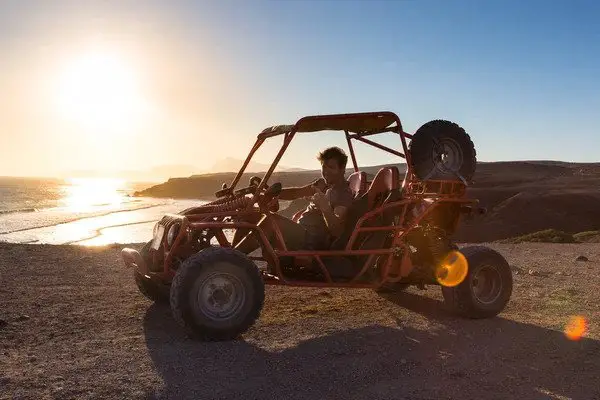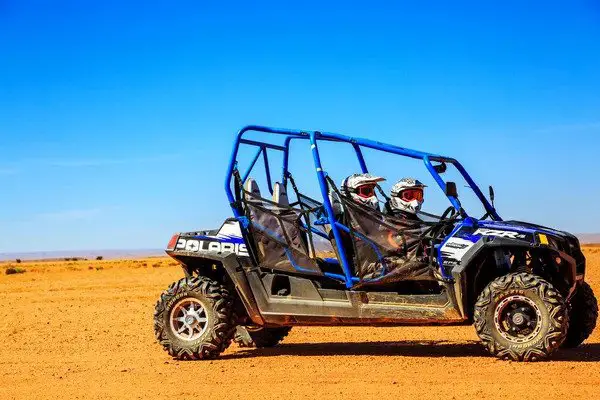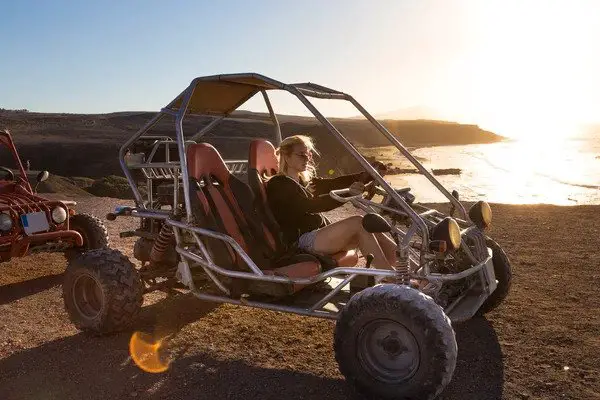UTVs and dune buggies are very similar. Their models are so identical that many people mistake them for one another. The reason for this is not human error but rather the fact that they have many characteristics in common.
Read this article that compares UTVvs dune buggy to discover which off-road vehicle is best for you.
Contents
Comparing UTVs and Dune Buggies

Around 1970, beach buggies were all the rage in London. The concept originated in the United States, where they are known as ‘Dune Buggies.’
They were created in the 1960s by Bruce Meyers, a Californian boat builder who pioneered the use of fiberglass for watercraft. It was created as a result of Meyers’ inspiration to use the material to construct a vehicle with a lightweight frame based on a Volkswagen chassis.
Advancement never stops, so as additional models and iterations emerged, dune buggies gradually became more sophisticated. New vehicles were created that could travel off-road on difficult roads, rocky paths, and even mud. These vehicles later acquired the name UTVs.
Then it is safe to say that dune buggies are the prototypes of UTVs.
Both of these vehicles’ characteristics are very similar in today’s world. When selecting which one is best for you, there are a few significant distinctions between them that are worth highlighting.
These distinctions stem from its usage, horsepower, speed, suspension, racing capabilities, off-road performance, pricing, and so on.
Although some of these distinctions may appear obvious, several intricacies inside each must be explored and considered when selecting which one is best suited for your off-roading needs. So let’s delve in and analyze these today.
Here are the key distinctions and similarities of these vehicles:
Usage

Utility Trail Vehicles, or UTVs for short, are also known as side-by-sides and a variety of other names. This illustrates the vehicles’ enormous popularity. UTVs have been subsequently classified as sports models or work models.
Therefore, there are very few trails where these incredible cars wouldn’t operate, whether for work or pleasure.
Ideally, dune buggies are specialized vehicles that exclusively travel through and withstand the sand dunes. They are capable of tackling difficult trails. They have the appearance and behavior of UTVs, but with elegant embellishments and big cabins enough for a large group of people.
These vehicles undoubtedly predominate the deserts more than any other kind of car. They are the most popular in racing, exploration, touring, tourism excursions, and various other sports activities. Securing the borders of military installations located in the desert is a less well-known use of this vehicle.
Horsepower

Getting a wheeler that can drive on rugged trails, climb steep hills, navigate uneven highways, and glide over muddy terrain is a big ask. The same is true for overcoming the difficult nature of sands and dunes.
That is why the engines of both UTVs and dune buggies must be powerful.
A typical dune buggy, such as the Yamaha YXZ1000R SE, has 90 HP, which is frequently used to power the rear drive. Recently, the motor power has been dispersed throughout the quad, providing considerably improved performance and total control.
The Buckshot Racing X5R is another fantastic buggy that goes like a cheetah across the dunes, with horsepower ranging from 510 HP to 750 HP, depending on the specific setup. A turbo variant increases the power to 1200 HP, which is rather impressive!
The Polaris RZR XP Turbo is one of the most popular recreational UTVs on the market. Its turbocharged engine readily provides 168 HP to an all-wheel-drive system. The Can-Am Maverick X3 X RC Turbo RR is another stunning machine that combines a 195 HP motor in a lightweight frame to fit a very competent vehicle.
Speed

Because their main job is driving on unfeasible trails, UTVs aren’t very concerned about speed. As a result, they are perfectly pleased with a speed range of 45-85 mph. Most popular models surpass this limit, particularly those designed for race and leisure activities.
Dune buggies, on the other hand, are designed for adventure. As a result, they fly off the beach sand at speeds ranging from 70 to 95 mph with their aluminum wheels.
Suspension
Both UTVs and dune buggies have complex suspension systems that are necessary. The shocks and hops of the unusual terrain would otherwise traumatize whoever is riding these vehicles.
Unlike ordinary car suspension systems, these are huge and fairly noticeable.
The suspension utilized in a buggy differs somewhat from that used in a UTV. This is due to the contrasts in terrain they must contend with; for example, one is soft sand like a desert, while the other is frequently hard rock.
Though this isn’t usually the case, manufacturers occasionally use the same system in both vehicles.
Off-Road Performance
UTVs are all-purpose utility vehicles that can navigate almost any terrain or trail. In contrast, dune buggies are better suited to arid environments.
UTVs are significantly more adaptable and useful than dune buggies in general. They can also give greater stability in a variety of settings.
Sand Dunes Performance

Unlike the situation described above, dune buggies rule the sands. UTVs would still go far and wide, but they would lack the buggies’ agility, traction, and speed.
Racing Capabilities
Dune buggies often have more motor power and faster speeds than UTVs. This is more visible on the dunes, however. The UTV would demonstrate more control and dominance on a bumpy trail.
Thus, the determining element here is not just the muscular strength of the vehicle but also, and maybe more crucially, the location of the race.
Price
Both the UTV and dune buggy have a rather wide pricing range. It usually ranges from $15,000 to $50,000, with the most popular models selling for roughly $30,000.
Some outliers, such as the Tatum Dragon Sand Car, cost more than $120,000. The Zarooq Sand Racer, which costs more than $450,000, is another stunning vehicle. Currently, this vehicle is the only premium quad with complete functionality.
Conclusion
“UTV vs dune buggy” is a topic that is not discussed very often. A reason could be the similarities both of these vehicles share plenty of similarities.
A sand buggy would be a fantastic option in the obvious circumstance when desert usage is the main issue. All other things being equal, go for the adaptable and reasonably priced UTVs.
You May Also Like:

